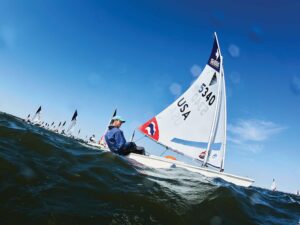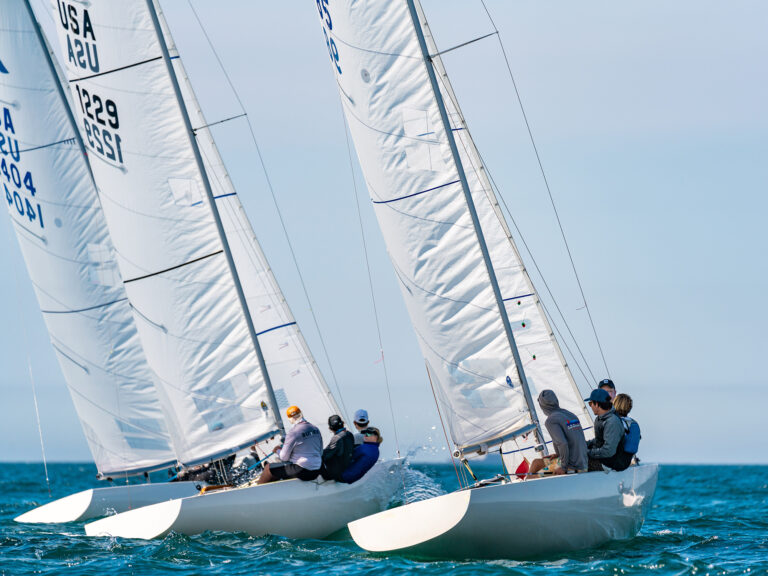Washington College
Location: Chestertown, Md.
Enrollment: 1,200 undergrads
Sailing Site: Chester River
Coaching Situation: Full-time head coach Bill Ward, plus part-time assistant Dan Rabin
Boats/Facilities: 12 FJs, 4 420s, 5 Lasers. Team shares facilities with crew team.
Funding: Waterfront sports at Washington College receive the bulk of their budget from the sale of donated yachts. The athletic department helps with travel expenses. The team also has an active alumni fund.
Program Profile: For over a decade, the team was a struggling club with four boats and marginal participation. At the peak of its plight, the athletic department considered doing away with the team. Thanks to waterfront director John Wagner, the team was granted varsity status in the fall of 1997. With the help of its first coach, Rob Breslin, the team progressed well and qualified for MAISA’s War and America trophies the next year. Washington College is a NCAA Division III school, which, Ward notes, makes it easier to get recognition and support for sailing. Ward plans to replace the team’s old 420s in 2001.
Did You Know? Washington College is the only college to which George Washington officially gave his name.
-Elizabeth Carroll
University of Vermont
Location: Burlington, Vt.
Enrollment: 7,400 undergrads (8,900 total)
Sailing Site: Lake Champlain
Coaching Situation: Full-time head coach, Greg Wilkinson
Boats/Facilities: 12 FJs based out of the Lake Champlain Community Sailing Center-office, boatyard, and ramp.
Funding: Two-thirds of the team’s annual budget comes from the Student Government Association, the rest comes through fundraising, as do the larger capital projects, such as the planned purchase of 18 420s in either fall 2001 or 2002.
Program Profile: When Wilkinson took over the program in 1996, the Vermont team had two 420s, a few decrepit Laser 2s, and the most black points (scheduling penalties for not showing at regattas) in NEISA. They purchased some used FJs, practiced hard in the chilly northern Vermont weather, and made the long drives to regattas, slowly but surely erasing their black points. Though regatta sites in NEISA are close compared to other districts, Burlington is 90 minutes from the team’s closest competition, and 3.5 hours from Boston. The team broke into the Sailing World national rankings in September 1999, later peaking at 14th. The biggest problem Wilkinson faces now is convincing other top programs to make the drive to Burlington for home regattas. When the school held NEISA’s singlehanded champs last October it was the first time most of the other coaches had been to Lake Champlain for a collegiate regatta.
Did You Know? The school sails on of the widest part of Lake Champlain (12 miles across), and the prevailing southerly often kicks up to 15 to 20 knots with 2- to 4-foot waves during practice.
-Peter Beardsley
University of California, Los Angeles
Enrollment: 24,700 undergrads (36,000 total)
Sailing Site: Marina del Rey
Coaching Situation: Student-coached. Alumni often drop by to help out at practice.
Boats/Facilities: 7 FJs. Team shares the UCLA Aquatic Center with the crew squad.
Funding: Membership dues pay for the bulk of the team’s expenses. The University’s Club Sports office offers some financial support.
Program Profile: UCLA’s sailing team benefits from having a University-owned Aquatic Center to practice out of, and a large pool of students from which to recruit. Marina del Rey, while crowded with traffic, is a good practice site with flat water and moderate winds-and don’t forget the warm Southern California weather. In combined practices with Pepperdine, the two teams can put 12 boats on the water. While the school’s top talents are seniors Gwen Garnett and Trisha Ward, there’s a strong pool of underclassmen, led by sophomore Lisa Harrison, ready to keep the team going. A largely female team this year, they’ve set their sights on qualifying for Women’s Nationals.
Did You Know? UCLA won the College Nationals in 1978.
-Rick Arneson
University of Minnesota
Location: Minneapolis, Minn.
Enrollment: 26,972 undergrads (45,481 total)
Sailing Site: Lake Minnetonka
Coaching Situation: Full-time coach, Gordy Bowers.
Boats/Facilities: 6 FJs, 4 420s. Full use of Wayzata YC.
Funding: Money comes from a combination of private donations and school support. The team just started a booster club.
Program Profile: In 1996, sailmaker and 1988 U.S. Olympic Head Coach Gordy Bowers joined Minnesota as head coach and turned a struggling three-person club into a 25-student team, complete with a constitution, bylaws, governing board, and captains. Since then, they’ve become a major player in the Midwest, finishing third at last fall’s MCSA Area West Eliminations. With the nearest competition over four hours away, the team spends a lot of time on the road and usually sails in only one regatta per weekend. Last year they sent sailors to the Coed Nationals and this past fall to Singlehanded Nationals. Bowers sees a bright future for the squad. “Rome wasn’t built in a day,” he says. “We’ve learned a lot, and the team’s really motivated.”
Did You Know? When the rest of the country pack up their boats for the winter, Bowers breaks out DN and Nite iceboats, and the team develops its love for speed on Minnesota’s hardwater.
-Chris Pastore
University of Florida
Location: Gainesville, Fla.
Enrollment: 31,600 undergrads (43,400 total)
Sailing Site: Lake Wauburg
Coaching Situation: Student-coached
Boats/Facilities: 10 420s, 12 Lasers. Boathouse and floating docks (shared with Lake Wauburg Facilities).
Funding: The Student Government distributes activities fees to all of the activities and clubs on campus. In 1998, the sailing team, led by team captain Angela Garcia, joined forces with all the other sports clubs on campus and arranged a “sit-in” at a Student Government meeting. The team’s budget was then raised from $1,500 to $20,000. Today, sailing is one of the best-funded club sports at the university.
Program Profile: Like any sports club that is run by its membership, the success of the team requires self motivation and hard work. Throughout the ’90s, Florida sailors proved their dedication by qualifying for at least one ICSA championship each year. The South Atlantic district is dominated by the College of Charleston, but the rest of the division is catching up. Programs like Eckerd and South Florida are getting stronger every year with Florida occasionally challenging Charleston’s position as the top dog in SAISA.
Did You Know? The bugs don’t bite at Lake Wauburg. University researchers genetically engineered the Blind Mosquito, which has no stinger. These “stingless” bugs drove the native, biting breed out of Lake Wauburg.
-E.C.
University of Kansas
Location: Lawrence, Kan.
Enrollment: 19,000 undergrads (25,400 total)
Sailing Site: Lake Clinton, a 20-square-mile man-made lake 2 miles from campus.
Coaching Situation: Volunteer head coach, Norm Castle
Boats/Facilities: 10 420s, 5 Lasers. Storage shed doubles as a clubhouse.
Funding: Well supported by the school, private donations, and an enthusiastic local sailing community. A recent $25,000 donation allowed the team to purchase five new Club 420s last September.
Program Profile: Since the 1960s, the Kansas sailing club has attracted mostly recreational sailors, but in 1999 a motivated racing contingent sparked a competitive growth spurt. The team is the most inland of the SEISA schools and consistently logs 1,200-mile weekends, but there are 40 team members and 20 who consistently practice and travel to regattas. They’ve racked up solid finishes at recent intersectionals and are looking forward to next year’s new recruits. The club is currently working to raise more money through grants and club-run sailing lessons in order to build a new boathouse and dock system. Team dues of $50 per semester cover gear, including PFDs, boots, spray smocks, and drysuits.
Did You Know? With over 40 bars in Lawrence, the University of Kansas has a 550 student-to-bar ratio. Kansas has been named a top party school by the Princeton Review.
-C.P.









